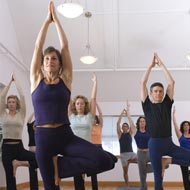- Aromatherapy (36)
- Benefits of Yoga (282)
- Home Remedies (1087)
- massage therapy (9)
- Preventive Therapy (135)
- Running (41)
- Skin Care (15)
- Stress Relief (25)
- Stretching (5)
- walking (33)
- Womens Health (14)
- Yoga Benefits for Pregnant Women (16)
- Yoga Benefits for Students (3)
- Yoga for Children (11)
- Yoga for Holistic Living (37)
- Yoga for Midlife Crisis (3)
- Yoga for Senior Citizens (2)
- Yoga for the Workplace (1)
- Yoga Health Tips (185)
- Yoga Practice during Menstruation (5)
Difference Between Yoga Sequences and Postures

Yoga is an ancient fitness routine that was developed in India thousands of years ago. Most yoga exercises, or Asanas, mimic the natural movements of animals and help to stretch and strengthen the body. These Asanas are even named after the many animals that they copy, such as the Cobra Pose (Bhujanga Asana), Matsya Asana (Fish Pose), Shalabha Asana (Locust Pose), Simha Asana (Lion Pose), Ushta Asana (Camel Pose), and Vrischika Asana (Scorpion Pose).
Yoga postures provide a number of benefits to the body. They not only provide a good stretch to the muscles, joints, and tissue, but also promote the circulation of blood. These postures also strengthen the muscles, bones, and joints. Some yoga poses even massage the internal organs of the body and improve their functioning.
Now suppose you wanted to strengthen your core, back, and shoulder muscles, you’d perform a posture such as the Bhujanga Asana, right? Well, not quite. You see yoga doesn’t work in the same way as most other exercises. Suppose you were weight training and you wanted to build good biceps, you’d do lots of bicep curls to target that area. However, yoga does not believe in working body parts in isolation.
Yoga is a holistic form of exercise. It follows a total mind-body approach and seeks to integrate all aspects of good health, physical, mental, and emotional, into a comprehensive exercise program. This unique approach is what makes yoga such a powerful tool for health and wellness. Thus, in order to gain the maximum benefits from yoga, you need to perform all the yoga exercises in the prescribed order.
A yoga sequence is a series of yoga postures that is scientifically formulated to provide maximum benefits. These sequences utilize postures that complement each other and provide the body with a complete holistic cure.
One of the most famous yoga sequences is the Surya Namaskara (Sun Salutation). The Sun Salutation is a series of twelve poses that are performed sequentially. This sequence is composed of a number of individual postures including the Tada Asana (Mountain pose), Urdhva Hasta Asana (Raised hands pose), Utana Asana (Flat back pose), Adho Mukha Svana Asana (Downward facing dog pose), and Urdhva Muhka Svana Asana (Upward facing dog pose).
Although these postures are beneficial when practiced on their own, when combined in a sequence, as is done in the Surya Namaskara, their benefits are increased manifold, and they can be used to provide a total body workout in a matter of minutes.
- RSS Feeds -
- All posts
- All comments
- Lower High BP With Yoga High blood pressure is one of the most prevailed ailments in the world right ...
- Tips To Prevent Turkey Neck Turkey neck is one of the nightmares that horrify men and women both. It can ...
- Yoga to Balance the Doshas Typically, it is believed that there are five key elements that make up t...
- Head Massage Techniques Getting a good head massage is a very nice idea to relieve stress. It does no...